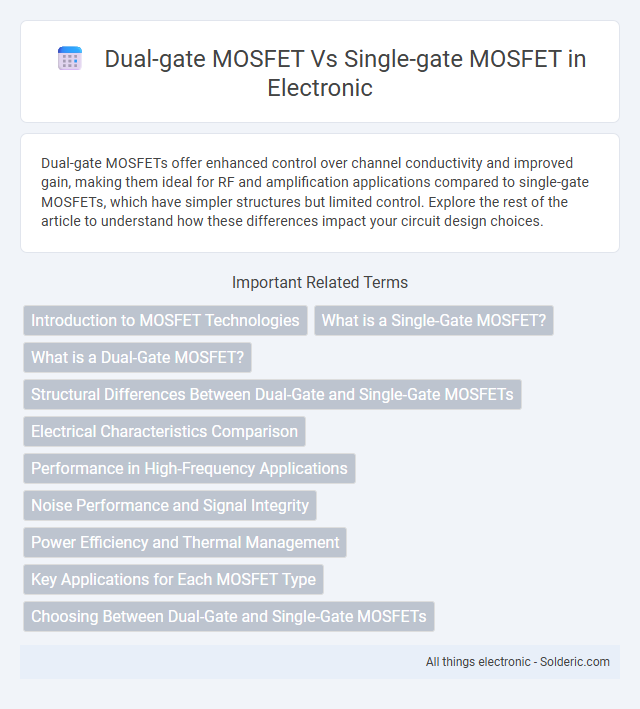Dual-gate MOSFETs offer enhanced control over channel conductivity and improved gain, making them ideal for RF and amplification applications compared to single-gate MOSFETs, which have simpler structures but limited control. Explore the rest of the article to understand how these differences impact your circuit design choices.
Comparison Table
| Feature | Dual-gate MOSFET | Single-gate MOSFET |
|---|---|---|
| Gate Structure | Two independent gates controlling the channel | One gate controlling the channel |
| Control Capability | Enhanced control over channel conductivity and gain | Standard control limited to one gate |
| Noise Figure | Lower noise, suitable for RF applications | Higher noise compared to dual-gate MOSFET |
| Gain | Higher gain due to two gates | Lower gain |
| Frequency Response | Better high-frequency performance | Moderate frequency response |
| Applications | RF amplifiers, mixers, and tunable circuits | General purpose amplification and switching |
| Complexity | More complex fabrication and biasing | Simple fabrication and biasing |
| Cost | Higher cost due to complexity | Lower cost |
Introduction to MOSFET Technologies
Dual-gate MOSFETs feature two independent gates controlling the channel, enhancing control over current flow and improving amplification and frequency response compared to single-gate MOSFETs. Single-gate MOSFETs have a simpler structure with one gate, suited for basic switching and amplification tasks with lower complexity and cost. Your choice between dual-gate and single-gate MOSFET technologies depends on the specific application requirements like signal amplification precision and noise reduction.
What is a Single-Gate MOSFET?
A Single-Gate MOSFET features one gate electrode controlling the current flow between the source and drain terminals by modulating the conductivity of the semiconductor channel. This structure offers simplicity and ease of fabrication, making it widely used in digital and analog circuits for switching and amplification tasks. Your device's performance in terms of speed and power consumption is influenced by the single-gate MOSFET's inherent control mechanism over charge carriers in the channel.
What is a Dual-Gate MOSFET?
A Dual-Gate MOSFET features two independent gates controlling the conductivity of a single channel, allowing enhanced modulation of current compared to a Single-Gate MOSFET, which has only one gate. This structure provides superior gain control, improved noise performance, and greater flexibility in RF applications, especially in mixers and amplifiers. The ability to separately bias each gate enables precise control over device operation, making Dual-Gate MOSFETs ideal for high-frequency circuit designs.
Structural Differences Between Dual-Gate and Single-Gate MOSFETs
Dual-gate MOSFETs feature two gates controlling the channel, enabling improved control over current flow and enhanced frequency response compared to single-gate MOSFETs, which have only one gate. The dual-gate structure typically involves two independent gate electrodes separated by an oxide layer, allowing for better noise reduction and gain control in RF applications. Your choice of device depends on the required electrical performance, with dual-gate MOSFETs offering more complexity and flexibility in circuit design.
Electrical Characteristics Comparison
Dual-gate MOSFETs exhibit superior electrical characteristics compared to single-gate MOSFETs, including enhanced transconductance and improved signal-to-noise ratio due to the independent control of two gates. The dual-gate structure facilitates better gain control and reduced parasitic capacitances, resulting in faster switching speeds and higher frequency operation. In contrast, single-gate MOSFETs typically suffer from higher gate-to-channel capacitance and limited control over channel conductance, leading to lower overall performance in RF and high-frequency applications.
Performance in High-Frequency Applications
Dual-gate MOSFETs exhibit superior performance in high-frequency applications due to their enhanced gain control and reduced Miller effect, enabling better amplification and lower noise figure compared to single-gate MOSFETs. The second gate allows independent biasing, which improves linearity and stability at microwave and RF frequencies, making them ideal for mixers and amplifiers in communication systems. Single-gate MOSFETs generally suffer from higher input capacitance and reduced frequency response, limiting their efficiency in high-speed and high-frequency circuits.
Noise Performance and Signal Integrity
Dual-gate MOSFETs exhibit superior noise performance compared to single-gate MOSFETs due to their enhanced control over channel conduction, which reduces flicker and thermal noise levels. The second gate allows for improved signal integrity by enabling better isolation and gain control, minimizing signal distortion and crosstalk in high-frequency applications. These characteristics make dual-gate MOSFETs particularly advantageous in RF amplifiers and low-noise front-end circuits where maintaining signal fidelity is critical.
Power Efficiency and Thermal Management
Dual-gate MOSFETs offer enhanced power efficiency by enabling better control of channel conduction, reducing leakage currents compared to single-gate MOSFETs. The improved gate control in dual-gate devices also leads to lower on-resistance, which minimizes power dissipation and heat generation. Effective thermal management in dual-gate MOSFETs results from their reduced thermal resistance, allowing more efficient heat spreading and improved device reliability under high-power operation.
Key Applications for Each MOSFET Type
Dual-gate MOSFETs excel in high-frequency and RF applications, such as mixers and amplifiers in communication systems, due to their enhanced gain control and improved isolation between gates. Single-gate MOSFETs are widely used in digital circuits, power management, and general-purpose switching applications because of their simpler design and cost-effectiveness. Your choice depends on the need for precise control and isolation in RF environments versus straightforward switching performance in conventional electronics.
Choosing Between Dual-Gate and Single-Gate MOSFETs
Choosing between dual-gate and single-gate MOSFETs depends on your specific application requirements, such as noise performance, gain control, and frequency response. Dual-gate MOSFETs offer enhanced control over amplification by providing two independent gates, which is ideal for RF amplification and mixer circuits in communication devices. Single-gate MOSFETs, being simpler and more cost-effective, suit general-purpose switching and low-frequency amplification tasks where such complex control is not necessary.
Dual-gate MOSFET vs Single-gate MOSFET Infographic

 solderic.com
solderic.com